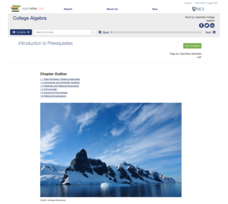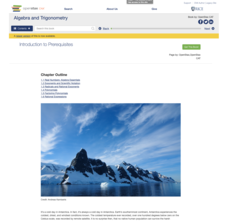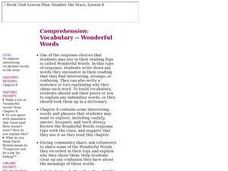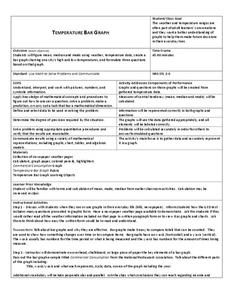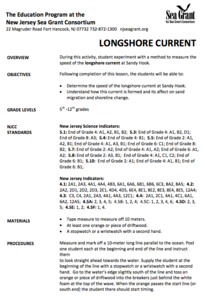Savvas Learning
Verbs: Future
As part of their study of future tense verbs, language learners engage in activities, read fables, and sing songs. The 25-page packet includes detailed lessons, worksheets, graphic organizers, and answer keys for assessments.
Curated OER
What Are My Chances?
Students calculate probability. In this lesson on probability, students use given data to calculate to chances of a given event occurring. Many of the calculations in this lesson are applicable to daily life.
Curated OER
Measuring Temperature
Students conduct an experiment using the steps of the scientific method. In this scientific method lesson plan, students experiment with temperature and record their findings using the scientific method. Students complete a data sheet...
Curated OER
Home in the Desert: Lesson for Use with This House is Made of Mud
Third graders examine how a family modifies their environment to create a home out of mud. They read the book "This House is Made of Mud" by Ken Buchanan, and write a description of their own home that compares the home of mud to their...
Curated OER
Pastimes
Students define and discuss personal pastimes, listen to the story Owl Moon by Jane Yolen, discuss owling as rural pastime, demonstrate comprehension by writing responses to story, and discuss how climate and geography often determine...
Curated OER
Stochastic and Deterministic Modeling
Explore the difference between stochastic and deterministic modeling through programming. First have the class write algorithms for relatively simple tasks using pseudocode. Use the Python 2.7 program app to simulate Mendel's Pea Pod...
Rice University
College Algebra
Is there more to college algebra than this? Even though the eBook is designed for a college algebra course, there are several topics that align to Algebra II or Pre-calculus courses. Topics begin with linear equation and inequalities,...
Rice University
Algebra and Trigonometry
Move on into trigonometry. An informative eBook takes the content of a College Algebra course and adds more relating to trigonometry and trigonometric functions. The content organization allows pupils to build upon their learning by...
Curated OER
Warm and Cold Air
Students conduct an experiment to discover what happens to air when it is heated or cooled, discover that wind moves from a high-pressure area (an area of sinking air) to a low pressure area (an area of rising air).
Curated OER
El Niño ~ The Return of El Niño
El Niño sure creates a stir when it comes around! Why not stir up your earth science class with this data analysis activity that examines the temperature and precipitation over the 2002-2003 water year. A tracking chart is provided...
Curated OER
Cloud Observations using GLOBE Protocols
Students observe which of ten types of clouds are visible and how much of the sky is cloud covered. They see that by observing clouds, we can get information about temperature, moisture, and wind conditions in different places in the...
Curated OER
Flight Formation: The V's Have It!
Read, revisit, and reflect. Older elementary learners summarize main idea 6using key details. They consider the V formation that birds fly in, summarize an informational text, and write critical thinking questions.
Curated OER
Seasons and Cloud Cover, Are They Related?
Students use NASA satellite data to see cloud cover over Africa. In this seasons lesson students access data and import it into Excel.
Curated OER
Marble Mania
Students explore the concept of probability. In this probability lesson, students develop an understanding of probability by pulling marbles out of a bag and recording the data. Students use the recording sheet to discuss the results of...
Curated OER
Where Does Your Garbage Go?
The objective of this lesson is to teach students about the importance of recycling. Initially, students have a chance to think about their impact on our planet by following the path that garbage takes. Students then learn about how...
Curated OER
Comprehension: Vocabulary - Wonderful Words
While reading Chapter 8 of Number the Stars, learners write down any words they encounter in their reading that they find interesting, strange, or confusing. They record why they chose each word, and after completing the reading...
Curated OER
Migration Activation
Students play the role of migrating birds. As a class, they simulate a migration of birds to one place and back again. They relate their habitat size and changes to their current population numbers. They discover the many dangers of...
Curated OER
Temperature Bar Graph
Students explore mean, median and mode. In this math lesson, students analyze temperature data and figure the mean, median, and mode of the data. Students graph the data in a bar graph.
Curated OER
Flood Cycles 30/100 or Somewhere In Between
Young scholars examine traditional flood cycles. They research floods that have occured between 30 and 100 years. They use a tool known as Climprob to study precipitation patterns that might cause floods.
Curated OER
Parts of an Ecosystem
Fourth graders study the Great Salt lake and the ecosystem that encompasses it. They study the relationship between an individual of a species, a population of that species, a community that includes that population, and the...
Curated OER
Sunlight and Warm Air
Students examine the different ways heat can be felt. In this radiation and conduction lesson plan, students recognize that the sun radiates heat. Students conduct three experiments to find how the sun warms the Earth and how that...
Curated OER
Dangerous Air
Students investigate how pollution is a global issue. They locate the countries affected by radiation from Chernobyl, sequence the progress of radiation transport from Chernobyl and plot the pollution points on a world map, and read and...
Curated OER
Longshore Current
Learners are posted at the beginning and end of a 10-meter long line parallel to the ocean and are instructed to look straight ahead towards the water. The student at the beginning of the line uses a stopwatch, goes to the water's edge...
Curated OER
What Shape is the Moon Tonight?
Students understand that the moon appears differently throughout the month. In this phases of the moon lesson, students observe and record the phases of the moon.






